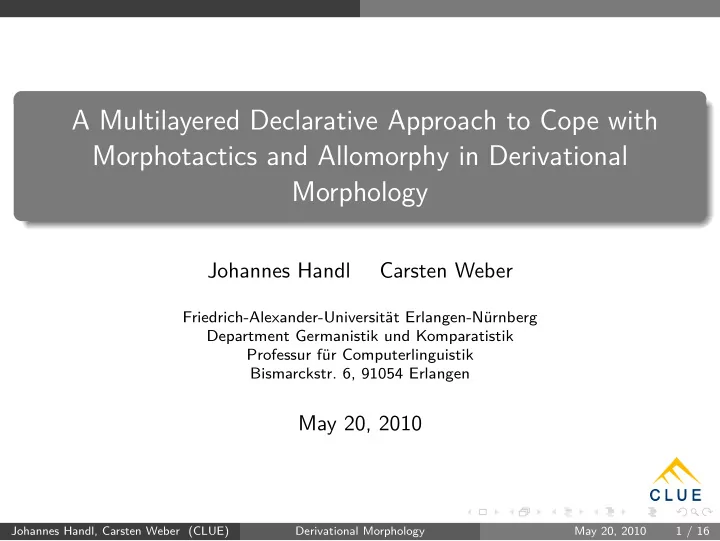

A Multilayered Declarative Approach to Cope with Morphotactics and Allomorphy in Derivational Morphology Johannes Handl Carsten Weber Friedrich-Alexander-Universität Erlangen-Nürnberg Department Germanistik und Komparatistik Professur für Computerlinguistik Bismarckstr. 6, 91054 Erlangen May 20, 2010 Johannes Handl, Carsten Weber (CLUE) Derivational Morphology May 20, 2010 1 / 16
Overview Introduction 1 JSLIM Left-Associative Grammar Allomorph Method Derivational Morphology 2 Evaluation 3 Further Improvements 4 Johannes Handl, Carsten Weber (CLUE) Derivational Morphology May 20, 2010 2 / 16
Introduction JSLIM JSLIM - Parser for Natural Language Analysis a software system for writing grammars implemented in Java grammars for morphology, syntax and semantics (cf. Handl et al. 2009) framework of the SLIM theory of language (cf. Hausser 2001) Johannes Handl, Carsten Weber (CLUE) Derivational Morphology May 20, 2010 3 / 16
Introduction JSLIM JSLIM - Key Features non-recursive feature structures (proplets) nesting can be simulated (cf. Hausser 2006) declarative syntax rule-based grammar development easy upscaling Johannes Handl, Carsten Weber (CLUE) Derivational Morphology May 20, 2010 4 / 16
� � � � Introduction Left-Associative Grammar Left-Associative Grammar as our Grammar Formalism time-linear derivation order from left to right principle of possible continuations instead of principle of possible substitutions (PS-Grammar) . � ��������� � � � � � � � � � . � e � ��������� � � � � � � � � � . � tr ¨ aum � ��������� � � � � � � � � � . s � � � � � � � � � � � � � � � � � � � Sommer nacht Johannes Handl, Carsten Weber (CLUE) Derivational Morphology May 20, 2010 5 / 16
Introduction Allomorph Method The Allomorph Method unanalyzed word form surfaces Fr¨ aulein segmentation of word forms Fr¨ au | lein allomorphs Fr¨ au lein lookup during morphological analysis allomorph lexicon files Frau, Fr¨ au, e, er, lein, ... generation of allomorphs via allo rules elementary lexicon files Frau, e, er, lein, ... Johannes Handl, Carsten Weber (CLUE) Derivational Morphology May 20, 2010 6 / 16
Derivational Morphology Allomorphy Phenomena of German Allomorphic inflectional forms are not sufficient for building derivational forms. ⇒ Vowel mutation, example Fräulein (miss): Allomorphic inflectional = form Frau , but allomorphic derivational forms Frau and Fräu ⇒ e-elision, example Erdling (earthling): Allomorphic inflectional form = Erde , but allomorphic derivational form Erd ⇒ e-elision and vowel mutation, example Schüler (scholar) and Schulung = (schooling): Allomorphic inflectional form Schule , but allomorphic derivational forms Schul and Schül Johannes Handl, Carsten Weber (CLUE) Derivational Morphology May 20, 2010 7 / 16
Derivational Morphology Desiderata Logical subdivision of the allo rules Paradigmatic rules for handling inflectional allomorphy Distinct rules to generate allomorphic variants for derivation, i.e., rules which are applied independent of a given paradigm Logical subdivision of the lexicon files Paradigmatic lexicon files to describe inflection Separate lexicon files to describe derivation only No artificial redundancy! Johannes Handl, Carsten Weber (CLUE) Derivational Morphology May 20, 2010 8 / 16
Derivational Morphology Motivation Easy lexicon compilation Transparent lexicon structure which faciliates the task of maintaining, extending and debugging the morphology grammar Faster construction period as most of the allo rules can be applied paradigmatically Reduced memory consumption as the paradigmatic structure of most of the lexicon entries allows structure sharing Johannes Handl, Carsten Weber (CLUE) Derivational Morphology May 20, 2010 9 / 16
Derivational Morphology Treatment of Inflectional and Derivational Allomorphs Generation of allomorphs for inflection in a first preprocessor step Generation of allomorphs for derivation in a second preprocessor step Separate elementary lexicon files for inflectional and derivational allomorphs Two different sets of inflectional and derivational allo rules Merging of the generated allomorphs with the aim of avoiding redundant entries Johannes Handl, Carsten Weber (CLUE) Derivational Morphology May 20, 2010 10 / 16
Derivational Morphology Flowchart of Allomorph Generation elementary lexicon files inflectional allo rules derivational allo rules inflectional allomorphs derivational allomorphs merge allomorphs allomorph lexicon files Johannes Handl, Carsten Weber (CLUE) Derivational Morphology May 20, 2010 11 / 16
Derivational Morphology Generation of Derivational Allomorphs 1) Entries of the derivational elementary lexicon !template[allo: A_chen] ![sur] Balkon Blume ... 2) Applying derivational allo rules table A_chen: [sur] => [sur, noun, der] /(.*)([aou])([^aeiou])*e?/ => $1"$2$3/ /$0/ (chen) . 3) Generated derivational allomorphs !template[allo: A_chen der: chen] ![sur, noun] Balkön Balkon Blüm Blume ... Johannes Handl, Carsten Weber (CLUE) Derivational Morphology May 20, 2010 12 / 16
Evaluation Required Entries in the Allomorph Lexicon nouns verbs adj. all inflectional forms 28545 10565 6777 45887 derivative forms 10393 907 1194 12494 total 38938 11472 7971 58381 merged 28387 10557 6771 45715 reduction rate 27.1% 8.0% 15.1% 21.7% Most of the inflectional and derivational allomorphs are equal The merging reduces 21,7% of the generated allomorphs Johannes Handl, Carsten Weber (CLUE) Derivational Morphology May 20, 2010 13 / 16
Further Improvements Further Improvements Generation of allomorphs based on composition Extension of the rule-based system, e.g. treatment of hyphens Addition of derivational suffixes which are borrowed from foreign languages Johannes Handl, Carsten Weber (CLUE) Derivational Morphology May 20, 2010 14 / 16
Further Improvements References Handl, Johannes; Kabashi, Besim; Proisl, Thomas; Weber, Carsten (2009). JSLIM - Computational morphology in the framework of the SLIM theory of language. In Mahlow, Cerstin; Piotrowski, Michael (eds.): State of the Art in Computational Morphology: Workshop on Systems and Frameworks for Computational Morphology, SFCM 2009. Zürich: Springer. Hausser, Roland (2001). Foundations of Computational Linguistics. Human-Computer Communication in Natural Language. 2nd edition. Berlin, New York: Springer. Hausser, Roland (2006). A Computational Model of Natural Language Communication . Berlin, Heidelberg: Springer. Trost, Harald (1990). The application of two-level morphology to non-concatenative german morphology . Research Report RR-90-15. DFKI. Saarbrücken Johannes Handl, Carsten Weber (CLUE) Derivational Morphology May 20, 2010 15 / 16
Further Improvements Contact Johannes Handl Carsten Weber jshandl@linguistik.uni-erlangen.de cnweber@linguistik.uni-erlangen.de +49 9131 85 25905 +49 9131 85 29250 Visit also our JSLIM online demo at http://www.linguistik.uni- erlangen.de/clue/en/research/jslim/online-demo.html Johannes Handl, Carsten Weber (CLUE) Derivational Morphology May 20, 2010 16 / 16
Recommend
More recommend